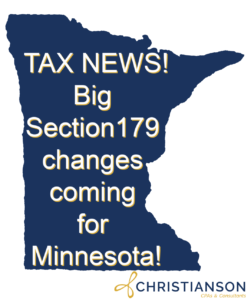 10/27/2020: The $1.36 billion bonding and tax bill signed by Gov Walz on October 21st includes full section 179 expensing conformity to the federal tax law as well as a provision to retroactively fix tax increases for like-kind exchanges in tax years 2018 and 2019.
10/27/2020: The $1.36 billion bonding and tax bill signed by Gov Walz on October 21st includes full section 179 expensing conformity to the federal tax law as well as a provision to retroactively fix tax increases for like-kind exchanges in tax years 2018 and 2019.
The Tax Cuts and Jobs Act (TCJA) signed into law in December 2017 was the most sweeping tax legislation since 1986. The law included the ability to expense up to $1 million with an investment limit of $2.5 million (adjusted each year for inflation). The law also eliminated the ability to utilize the like kind-exchange rules for equipment thus requiring a taxpayer to add to taxable income the gain from a trade of equipment. The taxpayer could then offset the gain by utilizing the increased depreciation expense allowances on the purchase of the new equipment. (In effect being tax liability neutral or reducing tax lability depending on the amount of boot paid).
What does this Mean for Minnesota?
The TCJA created huge headaches for Minnesota taxpayers. The 2018 returns included an 18-page MN form, including 10 pages of complicated worksheets which in effect converted a 2018 federal return to a 2017 return. In May of 2019, Minnesota passed legislation conforming to a large portion of the Federal TCJA, including the elimination of the ability to use the like-kind exchange rules for equipment. The tax conformity was retroactive, and Minnesota Revenue began the task of recalculating tax returns and sending notices (and tax bills) to taxpayers. Although the conformity bill eliminated many of the adjustments to recalculate Minnesota taxable income, one major piece was missing.
Minnesota has long required an addback to taxable income of 80% of bonus depreciation and Section 179 depreciation (except for allowing $25,000 in Section 179 depreciation with an investment limit of $200,000). The addback is then allowed as a deduction from Minnesota taxable income in equal amounts over the next 5 years. The conformity to the like-kind exchange elimination but not to the increased bonus and Section 179 depreciation limits created huge issues for many Minnesota taxpayers who had traded used equipment for new equipment. If the equipment had been depreciated, the trade created a substantial tax gain which was not able to be offset by accelerated depreciation of the new equipment because of the $25,000 Minnesota 179 expensing limit.
Section 179 Conformity
HF 1, passed with strong bi-partisan vote and signed into law on October 21st includes full section 179 conformity beginning in tax year 2020 which will increase the Section 179 expensing limit (Federal & Minnesota) to $1,040,000 with an investment limit of $2,590,000. Minnesota taxpayers will also no longer be required to add back the extra depreciation in the year of purchase and subtract it over the next 5 years. In addition, any taxpayer impacted by the elimination of the like-kind exchange rules will be excepted from including an addition to Minnesota taxable income on their 2018 & 2019 tax returns. Taxpayers will be required to amend their tax returns for this change. More details will be provided as they become available.
Doug Loon, president of the Minnesota Chamber of Commerce, a founding member of the Invest in Minnesota Coalition had the following to say regarding the bill, “Now more than ever, it’s critical to support Minnesota small businesses, as we all continue to feel the impact of the pandemic “Thanks to the elected officials who took this step to invest in the employees and communities which these businesses and farms support. This helps lay the foundation to help Minnesota’s economy recover and grow, and retain and create jobs.”




